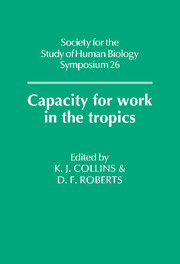Book contents
- Frontmatter
- Contents
- Preface
- Measurement of Working Capacity in Populations
- Functional Consequences of Malnutrition
- Growth, Stature and Muscular Efficiency
- Ethnic and Socio-Cultural Differences in Working Capacity
- Genetics of working capacity
- Working capacity in different African groups
- Environmental, genetic and leg mass influences on energy expenditure
- Sociocultural influences on the working capacity of elderly Nepali men
- Energy Expenditure and Endemic Disease
- Research Models in Tropical Ecosystems
- Index
Genetics of working capacity
Published online by Cambridge University Press: 15 March 2010
- Frontmatter
- Contents
- Preface
- Measurement of Working Capacity in Populations
- Functional Consequences of Malnutrition
- Growth, Stature and Muscular Efficiency
- Ethnic and Socio-Cultural Differences in Working Capacity
- Genetics of working capacity
- Working capacity in different African groups
- Environmental, genetic and leg mass influences on energy expenditure
- Sociocultural influences on the working capacity of elderly Nepali men
- Energy Expenditure and Endemic Disease
- Research Models in Tropical Ecosystems
- Index
Summary
INTRODUCTION
An outstanding feature of recent human evolution has been change in activity patterns. Today, many of us spend much of our time in sedentary tasks, making little use of the remarkable physical capacities with which our ancestors endowed us. If primitive man did not work, he did not eat, though that work would have incorporated a variety of activities and requirements – agility in climbing a tree for fruits, rapid bursts of speed in hunting and endurance in pursuit of wounded game, size and strength in the final attack on the quarry, and in carrying the proceeds of the hunt or the harvest back to the group. Success in such skills would obviously have been of survival importance, and natural selection would have favoured phenotypes enhancing that success. The genetic component of it, however small, is likely to have been selected for. Yet to establish the extent of that genetic component is extremely difficult.
Factors responsible for this are first the long human generation length, which makes it difficult to obtain comparable records for parents, children and other relatives. Secondly, there is the change in work capacity that comes in the long term with ageing and in the short term with variations in health, nutrition and similarly, and there is the difficulty of distinguishing the effects of intrinsic genetic characters from those due to environment. Then, most important, there is biological complexity itself. It is the almost infinite number of variables that are involved in work capacity that is mainly responsible for the difficulty in any attempt to measure the genetic contribution to it.
- Type
- Chapter
- Information
- Capacity for Work in the Tropics , pp. 181 - 192Publisher: Cambridge University PressPrint publication year: 1988



